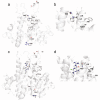Amantadine has potential for the treatment of COVID-19 because it inhibits known and novel ion channels encoded by SARS-CoV-2
- PMID: 34853399
- PMCID: PMC8636635
- DOI: 10.1038/s42003-021-02866-9
Amantadine has potential for the treatment of COVID-19 because it inhibits known and novel ion channels encoded by SARS-CoV-2
Erratum in
-
Author Correction: Amantadine inhibits known and novel ion channels encoded by SARS-CoV-2 in vitro.Commun Biol. 2021 Dec 10;4(1):1402. doi: 10.1038/s42003-021-02940-2. Commun Biol. 2021. PMID: 34893762 Free PMC article. No abstract available.
Abstract
The dire need for COVID-19 treatments has inspired strategies of repurposing approved drugs. Amantadine has been suggested as a candidate, and cellular as well as clinical studies have indicated beneficial effects of this drug. We demonstrate that amantadine and hexamethylene-amiloride (HMA), but not rimantadine, block the ion channel activity of Protein E from SARS-CoV-2, a conserved viroporin among coronaviruses. These findings agree with their binding to Protein E as evaluated by solution NMR and molecular dynamics simulations. Moreover, we identify two novel viroporins of SARS-CoV-2; ORF7b and ORF10, by showing ion channel activity in a X. laevis oocyte expression system. Notably, amantadine also blocks the ion channel activity of ORF10, thereby providing two ion channel targets in SARS-CoV-2 for amantadine treatment in COVID-19 patients. A screen of known viroporin inhibitors on Protein E, ORF7b, ORF10 and Protein 3a from SARS-CoV-2 revealed inhibition of Protein E and ORF7b by emodin and xanthene, the latter also blocking Protein 3a. This illustrates a general potential of well-known ion channel blockers against SARS-CoV-2 and specifically a dual molecular basis for the promising effects of amantadine in COVID-19 treatment. We therefore propose amantadine as a novel, cheap, readily available and effective way to treat COVID-19.
© 2021. The Author(s).
Conflict of interest statement
The authors declare that there are no competing interests in this work. All authors contributed to the writing of the manuscript and are accountable for all aspects of the work and all persons designated as authors qualify for the authorship, and all those who qualify for authorship are listed. All authors have read and approved the final version of the manuscript.
Figures





Comment in
-
Reply to: How Many SARS-CoV-2 "Viroporins" Are Really Ion Channels?Commun Biol. 2022 Aug 25;5(1):860. doi: 10.1038/s42003-022-03670-9. Commun Biol. 2022. PMID: 36008476 Free PMC article. No abstract available.
-
How many SARS-CoV-2 "viroporins" are really ion channels?Commun Biol. 2022 Aug 25;5(1):859. doi: 10.1038/s42003-022-03669-2. Commun Biol. 2022. PMID: 36008538 Free PMC article. No abstract available.
Similar articles
-
Efficacy of Ion-Channel Inhibitors Amantadine, Memantine and Rimantadine for the Treatment of SARS-CoV-2 In Vitro.Viruses. 2021 Oct 15;13(10):2082. doi: 10.3390/v13102082. Viruses. 2021. PMID: 34696509 Free PMC article.
-
[The antiviral targeting potential of viroporins].Ugeskr Laeger. 2022 Jun 13;184(24):V02220103. Ugeskr Laeger. 2022. PMID: 35703076 Review. Danish.
-
Mechanisms of Action of Novel Influenza A/M2 Viroporin Inhibitors Derived from Hexamethylene Amiloride.Mol Pharmacol. 2016 Aug;90(2):80-95. doi: 10.1124/mol.115.102731. Epub 2016 May 18. Mol Pharmacol. 2016. PMID: 27193582
-
Inhibition of SARS-CoV-2 Viral Channel Activity Using FDA-Approved Channel Modulators Independent of Variants.Biomolecules. 2022 Nov 11;12(11):1673. doi: 10.3390/biom12111673. Biomolecules. 2022. PMID: 36421688 Free PMC article.
-
SARS-CoV-2 Proteins: Are They Useful as Targets for COVID-19 Drugs and Vaccines?Curr Mol Med. 2022;22(1):50-66. doi: 10.2174/1566524021666210223143243. Curr Mol Med. 2022. PMID: 33622224 Review.
Cited by
-
SARS-CoV-2 ORF 3a-mediated currents are inhibited by antiarrhythmic drugs.Europace. 2024 Oct 3;26(10):euae252. doi: 10.1093/europace/euae252. Europace. 2024. PMID: 39412366 Free PMC article.
-
Ethical challenges of clinical trials with a repurposed drug in outbreaks.Med Health Care Philos. 2023 Jun;26(2):233-241. doi: 10.1007/s11019-023-10140-4. Epub 2023 Mar 7. Med Health Care Philos. 2023. PMID: 36881334 Free PMC article.
-
How many SARS-CoV-2 "viroporins" are really ion channels?Commun Biol. 2022 Aug 25;5(1):859. doi: 10.1038/s42003-022-03669-2. Commun Biol. 2022. PMID: 36008538 Free PMC article. No abstract available.
-
Amantadine in unvaccinated patients with early, mild to moderate COVID-19: A randomized, placebo-controlled, double-blind trial.Eur J Neurol. 2024 Jan;31(1):e16045. doi: 10.1111/ene.16045. Epub 2023 Sep 14. Eur J Neurol. 2024. PMID: 37584095 Free PMC article. Clinical Trial.
-
The effect of various compounds on the COVID mechanisms, from chemical to molecular aspects.Biophys Chem. 2022 Sep;288:106824. doi: 10.1016/j.bpc.2022.106824. Epub 2022 May 12. Biophys Chem. 2022. PMID: 35728510 Free PMC article. Review.
References
-
- Jefferson, T., Demicheli, V., Deeks, J. & Rivetti, D. Amantadine and rimantadine for preventing and treating influenza A in adults. Cochrane Database Syst. Rev. 19, CD001169 (2006). - PubMed
Publication types
MeSH terms
Substances
Grants and funding
- NF20OC0062899/Novo Nordisk Fonden (Novo Nordisk Foundation)
- R268-2017-409/Lundbeckfonden (Lundbeck Foundation)
- CoG, 682549/EC | EU Framework Programme for Research and Innovation H2020 | H2020 Priority Excellent Science | H2020 European Research Council (H2020 Excellent Science - European Research Council)
LinkOut - more resources
Full Text Sources
Miscellaneous

